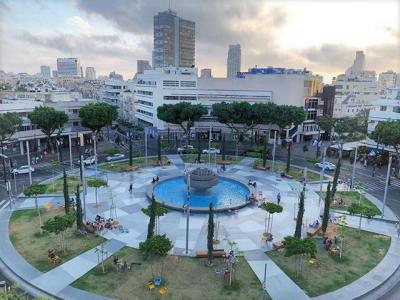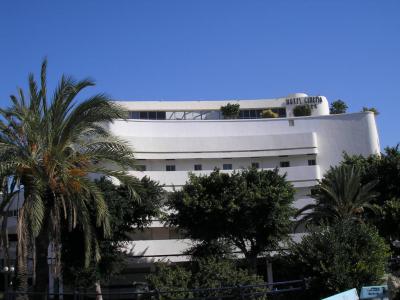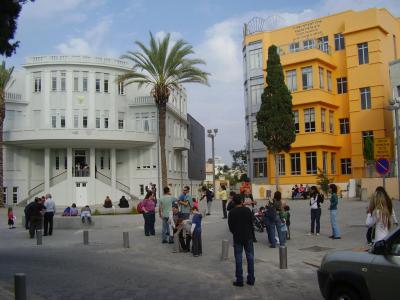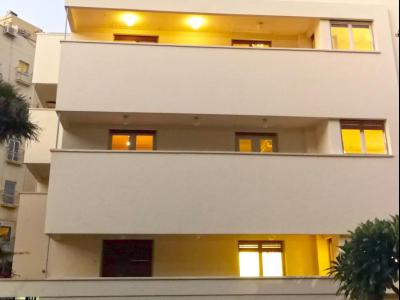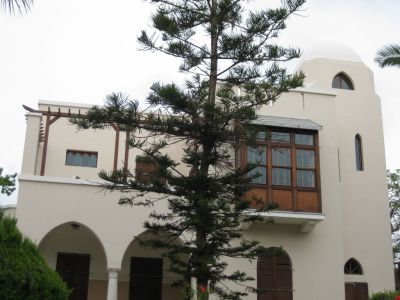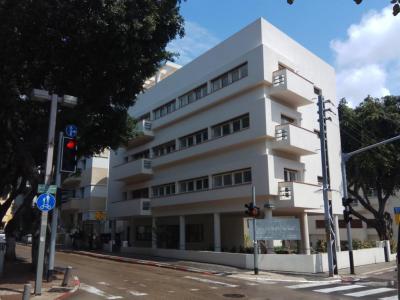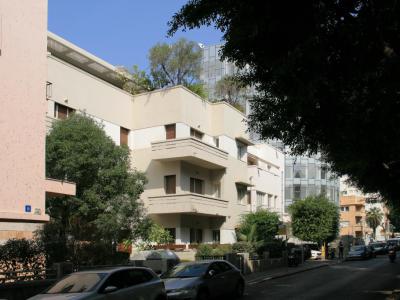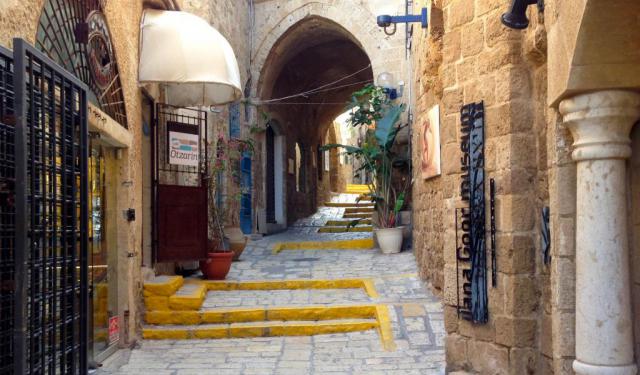Tel Aviv White City Architecture Tour (Self Guided), Tel Aviv
The White City area of Tel Aviv showcases a particular style of architecture that was brought from Germany by the first Jewish settlers in the 1930s. Considered “hottest” at the time, the Bauhaus (or International) architecture is represented by nearly 4,000 buildings in Tel Aviv. Although some of them feature elements typical of Modernism, they are distinguished by the more rigorous rules of volume expression, emphasizing functionality, minimalism (non-ornamentation), and geometric designs.
One of the focal points of this style is Dizengoff Circus, a bustling roundabout that showcases several Bauhaus buildings, among them the charming Cinema Hotel.
Bialik Square is another prominent spot where you can encounter White City's architectural wonders. In particular, here you'll find the Beit Ha'ir Museum, a cultural institution housed in a beautifully preserved Bauhaus building.
For those looking to explore this architectural style further, the Liebling House–White City Center and the Bauhaus Foundation are essential stops. These institutions provide a deeper understanding of the principles and history behind the White City architecture.
To get a taste of the lifestyle during the Bauhaus era, the Bet Bialik House Museum is a must-visit site. It offers a glimpse into the life of Israel's national poet, Chaim Nachman Bialik, in a well-preserved Bauhaus residence.
HaBima Square, home to the renowned Habima Theatre, offers additional examples of this iconic architecture. Further ahead, the Rubinsky House and the Engel House stand as exquisite representations of the style, with their clean lines and functional designs.
The tour of Tel Aviv's White City wouldn't be complete without a stroll down Rothschild Boulevard. Here, at number 61 stands an iconic edifice with a distinctive Bauhaus façade, making it a symbol of the architectural heritage in the heart of the city.
In essence, White City Architecture is a testament to Tel Aviv's cultural history. It invites visitors to step back in time and appreciate the beauty and innovation of the Bauhaus movement. To experience this unique architectural phenomenon firsthand, consider visiting the above locations on our self-guided walk and get yourself a captivating journey.
One of the focal points of this style is Dizengoff Circus, a bustling roundabout that showcases several Bauhaus buildings, among them the charming Cinema Hotel.
Bialik Square is another prominent spot where you can encounter White City's architectural wonders. In particular, here you'll find the Beit Ha'ir Museum, a cultural institution housed in a beautifully preserved Bauhaus building.
For those looking to explore this architectural style further, the Liebling House–White City Center and the Bauhaus Foundation are essential stops. These institutions provide a deeper understanding of the principles and history behind the White City architecture.
To get a taste of the lifestyle during the Bauhaus era, the Bet Bialik House Museum is a must-visit site. It offers a glimpse into the life of Israel's national poet, Chaim Nachman Bialik, in a well-preserved Bauhaus residence.
HaBima Square, home to the renowned Habima Theatre, offers additional examples of this iconic architecture. Further ahead, the Rubinsky House and the Engel House stand as exquisite representations of the style, with their clean lines and functional designs.
The tour of Tel Aviv's White City wouldn't be complete without a stroll down Rothschild Boulevard. Here, at number 61 stands an iconic edifice with a distinctive Bauhaus façade, making it a symbol of the architectural heritage in the heart of the city.
In essence, White City Architecture is a testament to Tel Aviv's cultural history. It invites visitors to step back in time and appreciate the beauty and innovation of the Bauhaus movement. To experience this unique architectural phenomenon firsthand, consider visiting the above locations on our self-guided walk and get yourself a captivating journey.
How it works: Download the app "GPSmyCity: Walks in 1K+ Cities" from Apple App Store or Google Play Store to your mobile phone or tablet. The app turns your mobile device into a personal tour guide and its built-in GPS navigation functions guide you from one tour stop to next. The app works offline, so no data plan is needed when traveling abroad.
Tel Aviv White City Architecture Tour Map
Guide Name: Tel Aviv White City Architecture Tour
Guide Location: Israel » Tel Aviv (See other walking tours in Tel Aviv)
Guide Type: Self-guided Walking Tour (Sightseeing)
# of Attractions: 12
Tour Duration: 2 Hour(s)
Travel Distance: 3.6 Km or 2.2 Miles
Author: max
Sight(s) Featured in This Guide:
Guide Location: Israel » Tel Aviv (See other walking tours in Tel Aviv)
Guide Type: Self-guided Walking Tour (Sightseeing)
# of Attractions: 12
Tour Duration: 2 Hour(s)
Travel Distance: 3.6 Km or 2.2 Miles
Author: max
Sight(s) Featured in This Guide:
- Dizengoff Circus
- Cinema Hotel
- Bialik Square
- Beit Ha'ir Museum
- Liebling House – White City Center
- Bauhaus Foundation
- Bet Bialik House Museum
- HaBima Square (Kikar HaBima)
- Rubinsky House
- Engel House
- 61 Rothschild Boulevard
- Rothschild Boulevard
1) Dizengoff Circus
Just in time for the 100th anniversary of the Bauhaus art school, which originated in Weimar Germany in 1919, the city of Tel Aviv successfully completed the restoration of Dizengoff Circus – likely the world's only "Bauhaus Piazza" – to its original design created by architect Genia Averbuch. Inaugurated in 1938 and regarded as the White City's traditional center, this place is striking for its simple layout: a round space, surrounded by nearly identical buildings, featuring curvilinear horizontal slit balconies.
Complete with lawns, benches and the renowned Fire and Water sculpture fountain at its center, the simple, elegant architectural language of this beautifully renovated square makes it a paradigm of local modernist architecture. Whenever strolling around it, you will find plenty of locals and tourists of all ages lolling about on the grass, taking a breather on one of the benches or simply using the place as a convenient, traffic-free thoroughfare.
Tip:
Conveniently located at the circle, LA SHUK (open daily: 12 noon – 12 midnight) is a great place to get a feel of Tel-Aviv's ambiance, cuisine, and service. Favorites include sea fish carpaccio and tartar, perfectly cooked fish and seafood flavored with local spices.
Complete with lawns, benches and the renowned Fire and Water sculpture fountain at its center, the simple, elegant architectural language of this beautifully renovated square makes it a paradigm of local modernist architecture. Whenever strolling around it, you will find plenty of locals and tourists of all ages lolling about on the grass, taking a breather on one of the benches or simply using the place as a convenient, traffic-free thoroughfare.
Tip:
Conveniently located at the circle, LA SHUK (open daily: 12 noon – 12 midnight) is a great place to get a feel of Tel-Aviv's ambiance, cuisine, and service. Favorites include sea fish carpaccio and tartar, perfectly cooked fish and seafood flavored with local spices.
2) Cinema Hotel
A former Bauhaus cinema centrally located in Dizengoff Square, this remarkable International-style construction with undulating balconies and geometric windows has been creatively renovated into a charming boutique hotel, and features film-themed decor and exhibits of vintage cameras and projectors, along with a gallery documenting the building's history. As a guest, you are witness to the memories of the famous Esther Cinema – one of the first movie halls in Tel Aviv – and to the new building that now houses it, which remains preeminent even amongst the city's abundance of UNESCO-recognized early twentieth-century architecture.
Although at the time of their construction, all the buildings around Dizengoff Square had a different purpose, they were carefully planned to form a circle, be three stories high, and have the same style of façade – despite the voiced concerns of some contemporary critics, who debated that a shared façade would go against the principles of modernist architecture. As the exhibition literature notes, "The use of concrete was a popular choice for Bauhaus/International-style architects, and the flowing concrete strips highlight a horizontal movement between the balconies and external walkways of each building in one continuous movement." Furthermore, its columns and pilotis (supports that lift a building above the ground or a body of water), are "typical of the local Bauhaus style."
Tip:
Frishman Street (a few blocks from the hotel) takes you to the beach and the spectacular boardwalk.
Although at the time of their construction, all the buildings around Dizengoff Square had a different purpose, they were carefully planned to form a circle, be three stories high, and have the same style of façade – despite the voiced concerns of some contemporary critics, who debated that a shared façade would go against the principles of modernist architecture. As the exhibition literature notes, "The use of concrete was a popular choice for Bauhaus/International-style architects, and the flowing concrete strips highlight a horizontal movement between the balconies and external walkways of each building in one continuous movement." Furthermore, its columns and pilotis (supports that lift a building above the ground or a body of water), are "typical of the local Bauhaus style."
Tip:
Frishman Street (a few blocks from the hotel) takes you to the beach and the spectacular boardwalk.
3) Bialik Square
Renovated in 2009, the small round Bialik Square is today a popular place, and together with surrounding buildings is an object of UNESCO World Heritage. More specifically, there are four architecturally-notable museums on its sides, of which one is the house where the greatest Hebrew poet of modern times, Chaim Nachman Bialik settled upon immigrating to Israel; another is the striking "old" town hall now housing exhibits on the city's development; and you also have the Bauhaus Museum and the Liebling Haus, both nicely capturing the essence of a Bauhaus building and inviting to explore their fascinating story from several perspectives.
Historically, the square is an integral part of the eponymous street, itself regarded as an urban museum, with architecture that ranges wildly from eclectic to Bauhaus. When not drawing in locals with a concert or dance party, the charming tree-lined street provides the opportunity for a little intimate stroll; you can spend some time walking around, sip a tasty coffee or go for a traditional meal nearby at a cozy café... Time here stands still if you allow it to, if only for a moment.
Historically, the square is an integral part of the eponymous street, itself regarded as an urban museum, with architecture that ranges wildly from eclectic to Bauhaus. When not drawing in locals with a concert or dance party, the charming tree-lined street provides the opportunity for a little intimate stroll; you can spend some time walking around, sip a tasty coffee or go for a traditional meal nearby at a cozy café... Time here stands still if you allow it to, if only for a moment.
4) Beit Ha'ir Museum
Constructed in 1925 and initially destined to be a hotel, this architectural pearl in the picturesque Bialik Square has served various purposes, but is more widely known as the house of the first Mayor of Tel Aviv, Meir Dizengoff ("Beit Ha'ir" literally means "the town's home"). With shows and events mostly during holidays, it contains (and is ideal for) permanent displays about the city's history, culture and architecture while also acting a stage for local and international artists, creators and intellectuals to showcase their works.
The museum traces the city's history from when the first Jews (66 families) arrived on 11 April 1909, and through following decades of urban development, so check out the interactive timeline display to gain some historical insight. Among other things, there are pictures from family albums, culled from tens of thousands sent in by people who live – or once lived – in Tel Aviv, and a fabulous collection of colorful tiles taken from floors of the city's earliest dwellings. Take the elevator – or winding stairs – up to the Dizengoff Room, restored just as it was when used as the official office of the first mayor – and with a great view of the city!
The museum traces the city's history from when the first Jews (66 families) arrived on 11 April 1909, and through following decades of urban development, so check out the interactive timeline display to gain some historical insight. Among other things, there are pictures from family albums, culled from tens of thousands sent in by people who live – or once lived – in Tel Aviv, and a fabulous collection of colorful tiles taken from floors of the city's earliest dwellings. Take the elevator – or winding stairs – up to the Dizengoff Room, restored just as it was when used as the official office of the first mayor – and with a great view of the city!
5) Liebling House – White City Center
Part of Tel Aviv's Bauhaus-style modernist heritage, the recently restored multi-family house by Tony and Max Liebling dates to 1936 and was most notable for being the first building in Israel to use elongated recessed balconies, an adaptation of Le Corbusier's strip windows. Apart from emphasizing the horizontal style, the narrow intervals between the building's parapet and overhang have the added practical effect of screening out the heat of the Mediterranean sun. The timbered pergola, a design element frequently seen in Jerusalem, is quite unusual for Tel Aviv.
Inside, the apartment building retains its original appearance; only the ground-floor room had its walls removed, in order to make room for the permanent exhibition and children's workshop area. Such apartments, with their high ceilings, opening to the shaded 'ribbon balconies', are normally hard to find today, as in most cases, the interior spaces have been changed beyond recognition.
The free audio app takes visitors on a self-guided tour exploring dozens of architectural elements and details (including the well-preserved – and extremely functional! – sanitary rooms), while also touching on the building's personal, cultural, economic, political, and social aspects as narrated by professionals, city residents, and members of the families who once lived here.
Completing the experience are the interesting art installations, the wonderful roof terrace, and the pretty café (plus garden) with its tempting delicacies – so if you care for building conservation, architecture, art, history, rooftop vistas, or even food, the Liebling House is certainly a place for you to visit.
Inside, the apartment building retains its original appearance; only the ground-floor room had its walls removed, in order to make room for the permanent exhibition and children's workshop area. Such apartments, with their high ceilings, opening to the shaded 'ribbon balconies', are normally hard to find today, as in most cases, the interior spaces have been changed beyond recognition.
The free audio app takes visitors on a self-guided tour exploring dozens of architectural elements and details (including the well-preserved – and extremely functional! – sanitary rooms), while also touching on the building's personal, cultural, economic, political, and social aspects as narrated by professionals, city residents, and members of the families who once lived here.
Completing the experience are the interesting art installations, the wonderful roof terrace, and the pretty café (plus garden) with its tempting delicacies – so if you care for building conservation, architecture, art, history, rooftop vistas, or even food, the Liebling House is certainly a place for you to visit.
6) Bauhaus Foundation
The Bauhaus Foundation in Tel Aviv has a private museum on the ground floor of a classic International Style building owned by American billionaire, businessperson, art collector and philanthropist Ronald Lauder. Perfectly preserved, the balanced cubic structure's prominent features – seen as outlandishly innovative back when it was erected in 1934 – are its unique shaded balconies, supported by a continuous square of vertical and horizontal pillars.
The display area of 120 square meters (1,300 square feet) contains furniture, graphics, lamps, glass and ceramic ware related to the Bauhaus movement of the 1920s and 1930s, as well as exhibitions about the International Style. Objects and furniture designed by famous artists such as Ludwig Mies van der Rohe, Marcel Breuer and Walter Gropius are included. The exhibits were loaned by private collections, mainly Lauder's own one.
Admission is free, but beware: it's open only twice a week!
The display area of 120 square meters (1,300 square feet) contains furniture, graphics, lamps, glass and ceramic ware related to the Bauhaus movement of the 1920s and 1930s, as well as exhibitions about the International Style. Objects and furniture designed by famous artists such as Ludwig Mies van der Rohe, Marcel Breuer and Walter Gropius are included. The exhibits were loaned by private collections, mainly Lauder's own one.
Admission is free, but beware: it's open only twice a week!
7) Bet Bialik House Museum
Haim Nachman Bialik, a Hebrew poet and painter, was a great inspiration to the younger generation of Hebrew poets. A house in which he lived until his death in 1934 is now a famous museum in Tel Aviv. It holds a special place in the hearts of Israelis who flock here to pay homage to the incredibly gifted artist. If you plan on a trip to Tel Aviv, a visit here should not be missed.
The Bet Bialik House is also a major architectural icon renowned for its unique combination of Mideastern and international styles. The museum comprises the poet’s library, dining room and writing room, all preserved exactly the same as they were when the owner still lived here.
The library contains all 94 books written by Bialik, complete with their translations in 28 languages. The collection also includes letters, photographs, paintings and other artifacts showcasing life during the pre-independence period. The museum guides speak Yiddish or Hebrew only. There is, however, a brochure in English. The admission is free.
Why You Should Visit:
A charming place, great for those wanting to see something different from a 'typical' museum.
Tip:
The Bialik House sits on the same block as the Reuven Rubin museum which is yet another lovely house museum showcasing his artwork.
The Bet Bialik House is also a major architectural icon renowned for its unique combination of Mideastern and international styles. The museum comprises the poet’s library, dining room and writing room, all preserved exactly the same as they were when the owner still lived here.
The library contains all 94 books written by Bialik, complete with their translations in 28 languages. The collection also includes letters, photographs, paintings and other artifacts showcasing life during the pre-independence period. The museum guides speak Yiddish or Hebrew only. There is, however, a brochure in English. The admission is free.
Why You Should Visit:
A charming place, great for those wanting to see something different from a 'typical' museum.
Tip:
The Bialik House sits on the same block as the Reuven Rubin museum which is yet another lovely house museum showcasing his artwork.
8) HaBima Square (Kikar HaBima)
Named after Israel's National Theatre, HaBima Square is a great public space mixing minimalistic design with usability and effectively acting as one of the city's focal points. Although on New Year's Eve (Hanukkah celebrations) it usually buzzes with activities and performances for the entire family, most times you'll just want to have a break from exploring while taking in the surroundings.
Despite the landscaping design being fairly recent, this is the location where the first master plan of Tel Aviv – as proposed by Patrick Geddes in the late 1920s – envisioned a kind of a "modern Acropolis" that would stand for the city's cultural core; hence, the cornerstone of HaBima Theatre was laid here in 1935, and the Frederick R. Mann Auditorium (renamed in honor of Charles R. Bronfman in 2013) soon followed. In keeping with the Bauhaus/International style, the impressive buildings are a part of the White City and intended for preservation as UNESCO world heritage sites.
Take some time to explore the various aspects of the square, from the more intimate corners of the sunken garden (there's a nice tendency for classical music to be piped out of the small recessed flower bed) to the water basin and the many restaurants and coffee shops around. Try to avoid the sunny hours, however, as the glare of the sun and the white paving don't make for the best match.
Tip:
To the north of the square sits the Helena Rubinstein Pavilion, a 1959 Bauhaus-style building for temporary exhibitions of contemporary local and international art.
Despite the landscaping design being fairly recent, this is the location where the first master plan of Tel Aviv – as proposed by Patrick Geddes in the late 1920s – envisioned a kind of a "modern Acropolis" that would stand for the city's cultural core; hence, the cornerstone of HaBima Theatre was laid here in 1935, and the Frederick R. Mann Auditorium (renamed in honor of Charles R. Bronfman in 2013) soon followed. In keeping with the Bauhaus/International style, the impressive buildings are a part of the White City and intended for preservation as UNESCO world heritage sites.
Take some time to explore the various aspects of the square, from the more intimate corners of the sunken garden (there's a nice tendency for classical music to be piped out of the small recessed flower bed) to the water basin and the many restaurants and coffee shops around. Try to avoid the sunny hours, however, as the glare of the sun and the white paving don't make for the best match.
Tip:
To the north of the square sits the Helena Rubinstein Pavilion, a 1959 Bauhaus-style building for temporary exhibitions of contemporary local and international art.
9) Rubinsky House
Designed in 1935 and restored in 2008, Rubinsky House symbolizes the birth of 'Israeli Bauhaus'. The first thing to note about it are the rows of hanging columns leading into the stairwell. This three-block residential building was, in fact, the first structure to obtain permits for such columns which, by favoring pragmatism and simplicity over beauty, quickly became the standard of modern construction throughout Israel.
Contrary to the spirit of Bauhaus, however, the street facades on Shenkin Street borrow elements from Modernism, here made evident in the awnings, rounded terraces and windows, hanging concrete beams and gutters, as well as scraped plaster with a glittering mineral aggregate typical of the period, all serving as decorative elements. The lobby, with its majestic staircase, leads to spacious apartments, but also to a new rooftop penthouse, which is not as immediately apparent from the street.
Contrary to the spirit of Bauhaus, however, the street facades on Shenkin Street borrow elements from Modernism, here made evident in the awnings, rounded terraces and windows, hanging concrete beams and gutters, as well as scraped plaster with a glittering mineral aggregate typical of the period, all serving as decorative elements. The lobby, with its majestic staircase, leads to spacious apartments, but also to a new rooftop penthouse, which is not as immediately apparent from the street.
10) Engel House
At Rothschild 84, the large residential Engel House, designed in 1933 by prolific architect Ze'ev Rechter, is mainly remembered by the public as "the building that put Tel Aviv up on pillars", allowing for better ventilation (through the shaded area) as well as for visual contact between the boulevard and the courtyard – thus giving the illusion of additional space within a densely populated city.
Inspired by Bauhaus/Modernist designs but adapted to the environment, the U-shaped building has protruding window frames to create shade – a substitute for the wide windows favored in Europe, which are unsuitable to Israel's climate. On the other hand, the roof – originally a communal space – once had a nice solarium and a gym, thus illustrating Le Corbusier's concept of the 'roof terrace'.
Having gotten frayed in the Mediterranean sun for many years, Engel House is finally back to its heyday, following a long and meticulous restoration.
Inspired by Bauhaus/Modernist designs but adapted to the environment, the U-shaped building has protruding window frames to create shade – a substitute for the wide windows favored in Europe, which are unsuitable to Israel's climate. On the other hand, the roof – originally a communal space – once had a nice solarium and a gym, thus illustrating Le Corbusier's concept of the 'roof terrace'.
Having gotten frayed in the Mediterranean sun for many years, Engel House is finally back to its heyday, following a long and meticulous restoration.
11) 61 Rothschild Boulevard
61 Rothschild Boulevard in Tel Aviv stands out as an architectural gem with its distinctive asymmetrical design and vibrant rooftop garden. This building uniquely offsets three front apartment blocks, creating a dynamic and multi-dimensional facade. This design approach not only enhances the visual appeal but also thoughtfully considers the privacy of its residents.
The building's facade disrupts the uniformity commonly seen along Rothschild Boulevard, making a bold architectural statement. At the same time, it successfully incorporates a large, shared garden at the front, offering a refreshing green space amidst the urban environment.
One of the key features of 61 Rothschild Boulevard is its corner windows. These windows are strategically positioned to maximize daylight exposure, ensuring that the apartments are bathed in natural light. To complement this, floating pergolas, a characteristic element of the International Style, provide necessary shade, enhancing comfort without compromising on light.
The building's alignment with original architectural designs is evident, yet it also embraces contemporary elements. Notably, the metal-and-glass rooftop apartment, added as part of the 2006 preservation project, is a modern touch. This rooftop addition is cleverly set back from the main facade, making it inconspicuous from the boulevard. This design choice not only preserves the building's historical aesthetics but also adds a layer of modern sophistication.
In summary, 61 Rothschild Boulevard is a remarkable example of architectural innovation, blending historical elements with modern design. Its asymmetrical structure, integrated green spaces, optimal use of natural light, and the harmonious combination of old and new elements make it a standout landmark in Tel Aviv.
The building's facade disrupts the uniformity commonly seen along Rothschild Boulevard, making a bold architectural statement. At the same time, it successfully incorporates a large, shared garden at the front, offering a refreshing green space amidst the urban environment.
One of the key features of 61 Rothschild Boulevard is its corner windows. These windows are strategically positioned to maximize daylight exposure, ensuring that the apartments are bathed in natural light. To complement this, floating pergolas, a characteristic element of the International Style, provide necessary shade, enhancing comfort without compromising on light.
The building's alignment with original architectural designs is evident, yet it also embraces contemporary elements. Notably, the metal-and-glass rooftop apartment, added as part of the 2006 preservation project, is a modern touch. This rooftop addition is cleverly set back from the main facade, making it inconspicuous from the boulevard. This design choice not only preserves the building's historical aesthetics but also adds a layer of modern sophistication.
In summary, 61 Rothschild Boulevard is a remarkable example of architectural innovation, blending historical elements with modern design. Its asymmetrical structure, integrated green spaces, optimal use of natural light, and the harmonious combination of old and new elements make it a standout landmark in Tel Aviv.
12) Rothschild Boulevard (must see)
Strolling along the wide Rothschild Boulevard, you'll see lots of people of all kinds, a small pool, historical sites like the “Independence Hall” from which the 1948 Proclamation of Independence was originally read (with statues on the balcony to simulate that), and, of course, many Bauhaus buildings – some better preserved than others. Almost like all the boulevards in Tel Aviv, it has become a sort of urban park with blankets spread out on the grass and many coffee shops in the middle as well as along it.
Adjacent to the famous Engel House, one of the most visually pleasing buildings on the boulevard is the state-of-the-art Braun-Rabinsky building, which stands out for its razor-sharp lines and a thermometer-like stairwell window that's dramatically illuminated at night. At number 71, you may spot the recently renovated Krieger House, its distinctive sunken balconies forming a strikingly attractive contrast with the façade's white surface, while at the intersection of Allenby St, you may even see a public expression of cultural/religious affinity: the large ceramic murals depict scenes of biblical agricultural activities, forming an integral part of the architecture.
Adjacent to the famous Engel House, one of the most visually pleasing buildings on the boulevard is the state-of-the-art Braun-Rabinsky building, which stands out for its razor-sharp lines and a thermometer-like stairwell window that's dramatically illuminated at night. At number 71, you may spot the recently renovated Krieger House, its distinctive sunken balconies forming a strikingly attractive contrast with the façade's white surface, while at the intersection of Allenby St, you may even see a public expression of cultural/religious affinity: the large ceramic murals depict scenes of biblical agricultural activities, forming an integral part of the architecture.
Walking Tours in Tel Aviv, Israel
Create Your Own Walk in Tel Aviv
Creating your own self-guided walk in Tel Aviv is easy and fun. Choose the city attractions that you want to see and a walk route map will be created just for you. You can even set your hotel as the start point of the walk.
A Walk Along the Seashore
In warm weather, there is no better way to enjoy yourself than right next to the water, especially in Tel Aviv. Composed of 13 official beaches, all of which are very well looked after and fitted with various facilities, Tel Aviv's coastal strip spans over a dozen kilometers, with many luxury hotels in the background, booming with events and happenings.
The beautiful Seashore area... view more
Tour Duration: 2 Hour(s)
Travel Distance: 4.7 Km or 2.9 Miles
The beautiful Seashore area... view more
Tour Duration: 2 Hour(s)
Travel Distance: 4.7 Km or 2.9 Miles
A Walk in The Old City of Jaffa
One of the oldest port cities on the Mediterranean coast, the first record of which dates back to the 15th century BC, Jaffa is a part of Tel Aviv, although quite different in terms of vibe. Famous for its ancient slate houses and narrow winding stone roads, it feels a bit similar to the ancient towns of Asia, but far less noisy and not too crowded.
Also, devoid of the strong religious... view more
Tour Duration: 2 Hour(s)
Travel Distance: 2.1 Km or 1.3 Miles
Also, devoid of the strong religious... view more
Tour Duration: 2 Hour(s)
Travel Distance: 2.1 Km or 1.3 Miles
Tel Aviv Introduction Walking Tour
The second largest metropolis in Israel, Tel Aviv started off as a humble settlement on the outskirts of the ancient city of Jaffa in the then part of Ottoman Syria. On 11 April 1909, 66 Jewish families gathered on a desolate sand dune to parcel out land via lottery organized by the Ahuzat Bayit building society. The lottery used 120 seashells collected on the beach, in which the society... view more
Tour Duration: 2 Hour(s)
Travel Distance: 4.1 Km or 2.5 Miles
Tour Duration: 2 Hour(s)
Travel Distance: 4.1 Km or 2.5 Miles
The Most Popular Cities
/ view all



